Zinc Production in India: Trends, Uses, and Market Impact| PriceVision
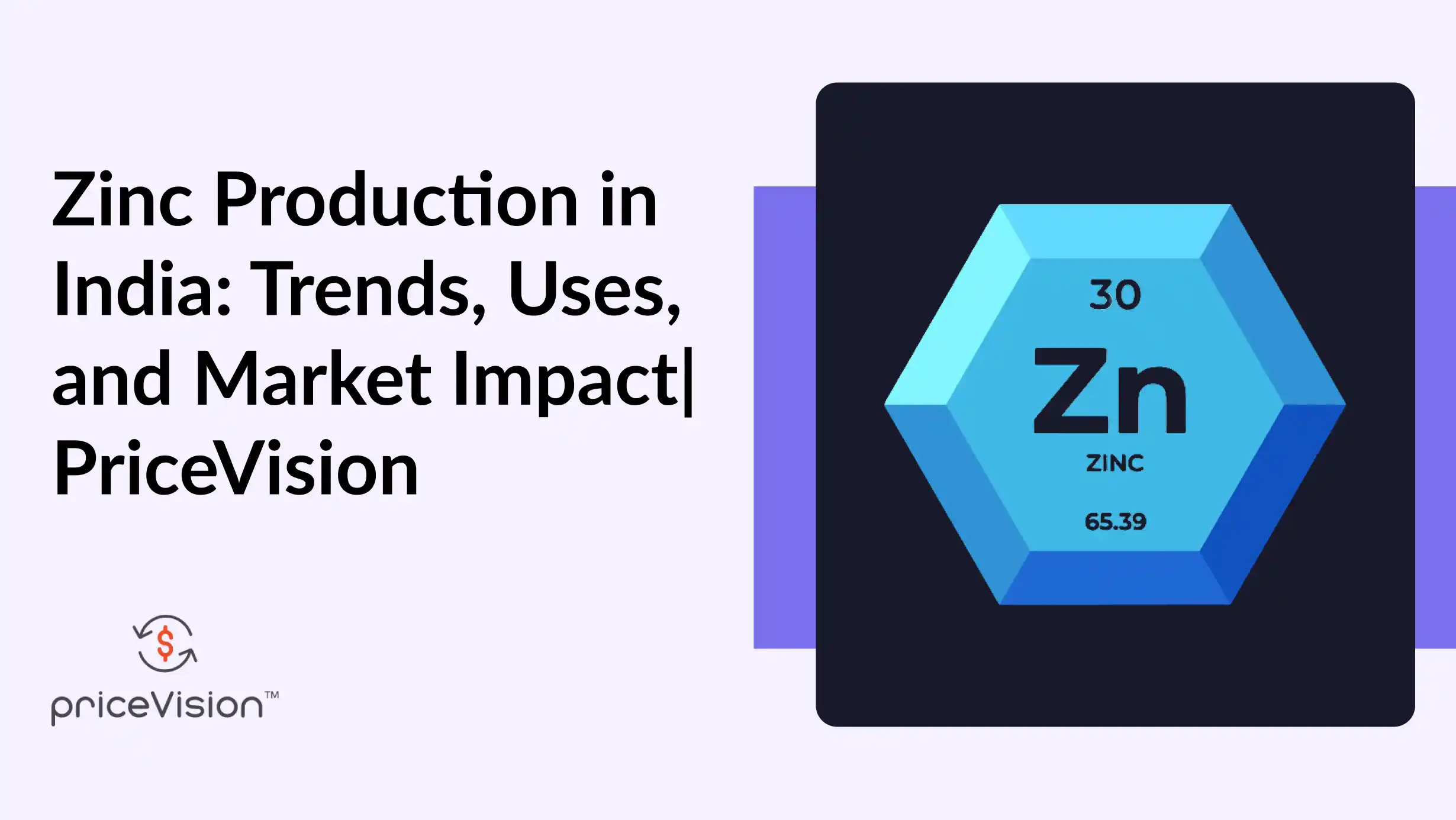
Zinc (Zn) presents as a metallic element that exhibits a greyish-white hue in its solid form, attributed to a coating of oxide enveloping its exterior. Its most significant use lies in the galvanizing technique, chiefly because it displays extraordinary characteristics: firstly, its remarkable ability to resist corrosion. Secondly, when zinc encounters iron, it acts as a sacrificial anode for the iron, deteriorating in its stead.
This metal is critical in numerous industrial activities, from manufacturing galvanized steel, crafting alloys, to the creation of batteries. India has established itself as a leader in both the production and application of zinc on a global scale, thanks to its rich zinc ore reserves and a supportive regulatory framework. The zinc prices are crucial for the Indian railway sector, which uses galvanized steel extensively to combat rust and enhance the longevity of its assets. This has caused the country’s zinc mining and refining sector to become a magnet for both local and foreign enterprises.
Why is Zinc So Valuable?
Often referred to as spelter in commerce, zinc falls under the category of transition metals. This bluish-white metal can refine other metals, and its non-corrosiveness ensures that it routinely coats steel and iron for protection. Brass, an alloy of zinc and copper, can contain copper in quantities ranging from 55% to 95%. Zinc’s role in galvanizing protects public and private investments in infrastructure from corrosion, indirectly influencing maintenance costs and longevity.
Humanity has reaped the advantages of zinc for ages. Nowadays, it serves an array of purposes, primarily for its qualities that inhibit the rusting of iron and steel, making up over half of its utility. Additionally, the manufacturing of various types of batteries, including alkaline, zinc-carbon, and zinc-air batteries, requires zinc. Fluctuations in zinc prices can impact the automotive sector in India, which relies on zinc for die-casting processes.
Not only is zinc vital for making different alloys like brass and bronze, but it also plays a crucial role in human health. The absence of sufficient zinc has tied numerous adverse health effects to zinc deficiency, indicating how vital it is to avert this condition.
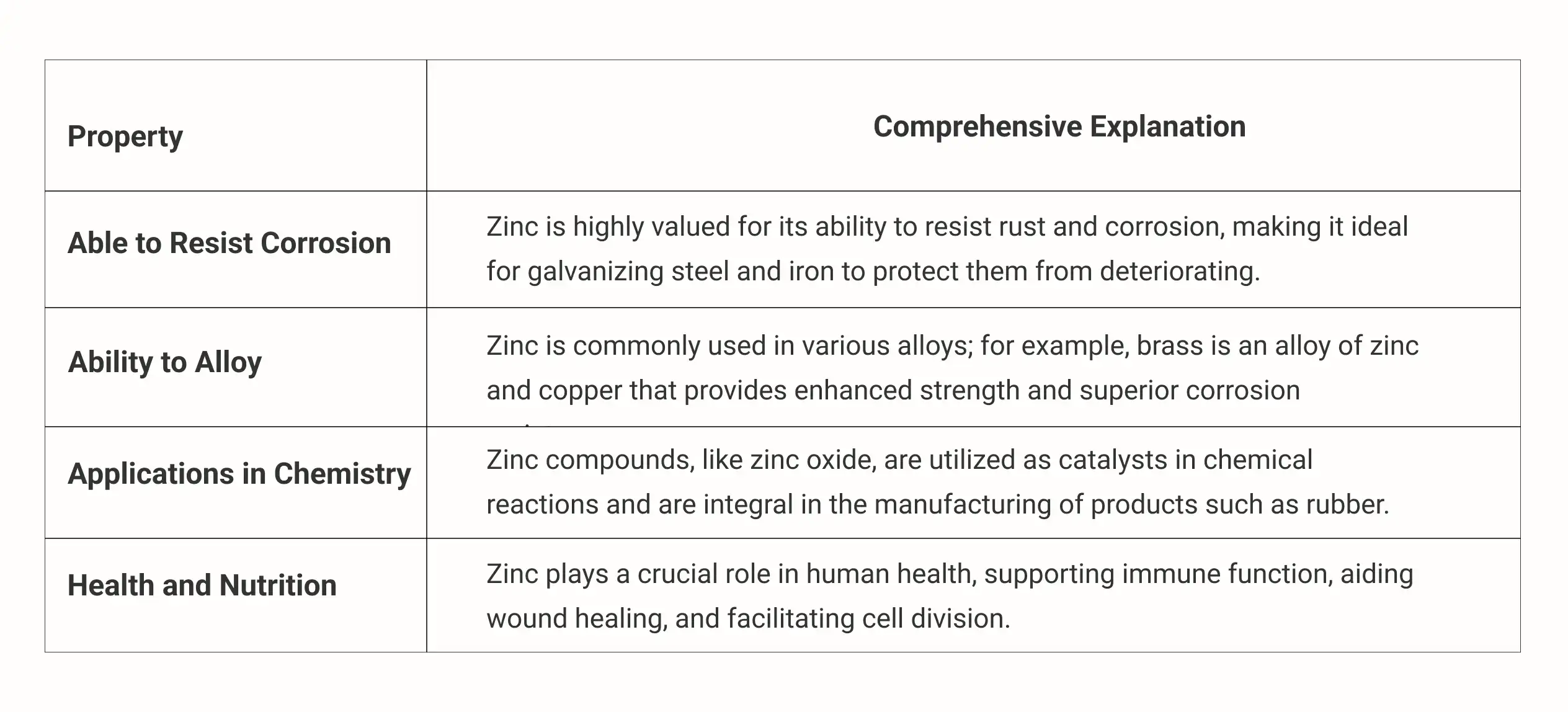
What Is The Use Of Zinc?
Half of the zinc produced goes towards galvanizing steel and iron. Zinc prices significantly influence the cost of infrastructure projects in India, as zinc is crucial for galvanizing steel used in construction.
Some More Applications of Zinc
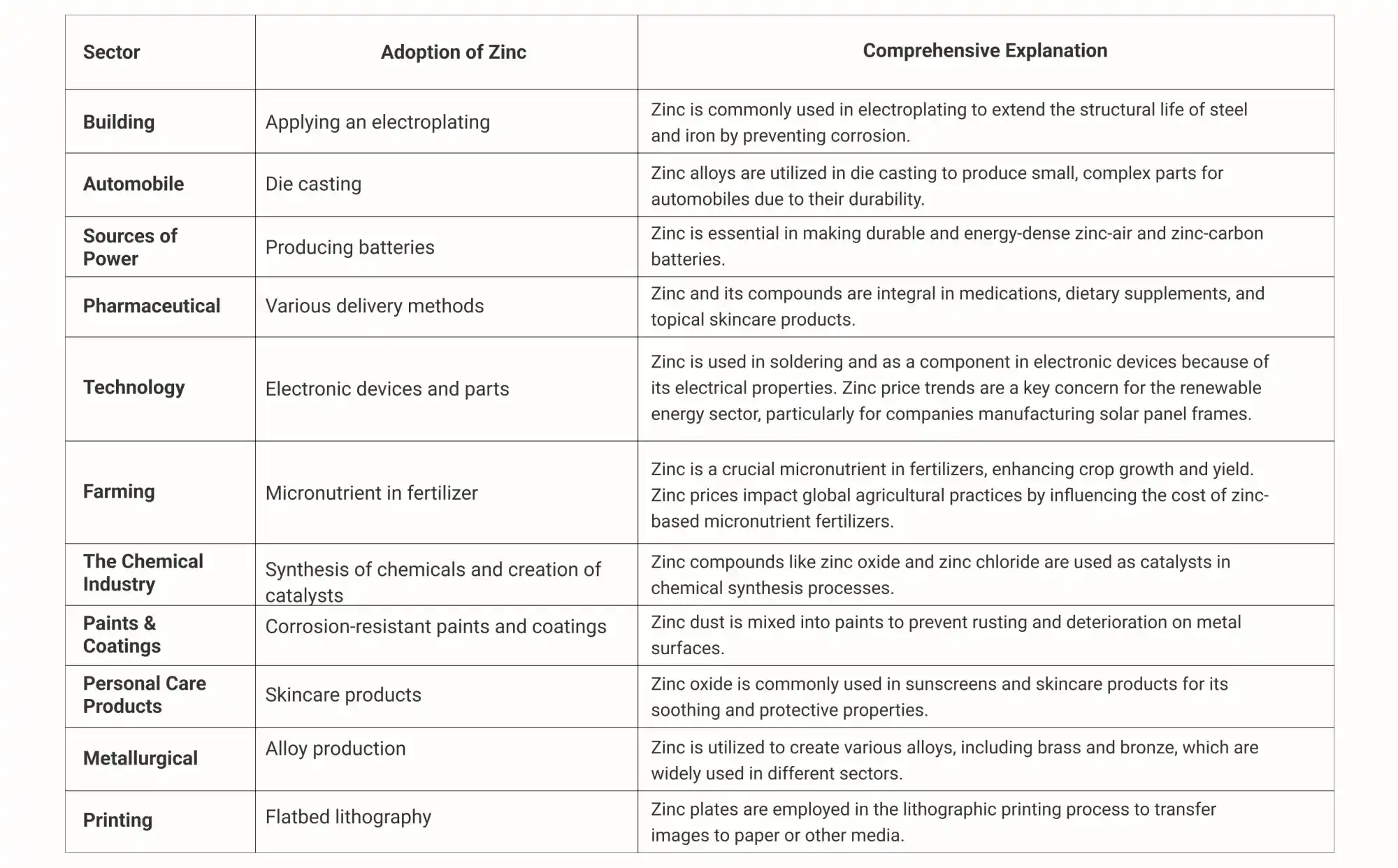
Refining Zinc: From Ore to Finished Good
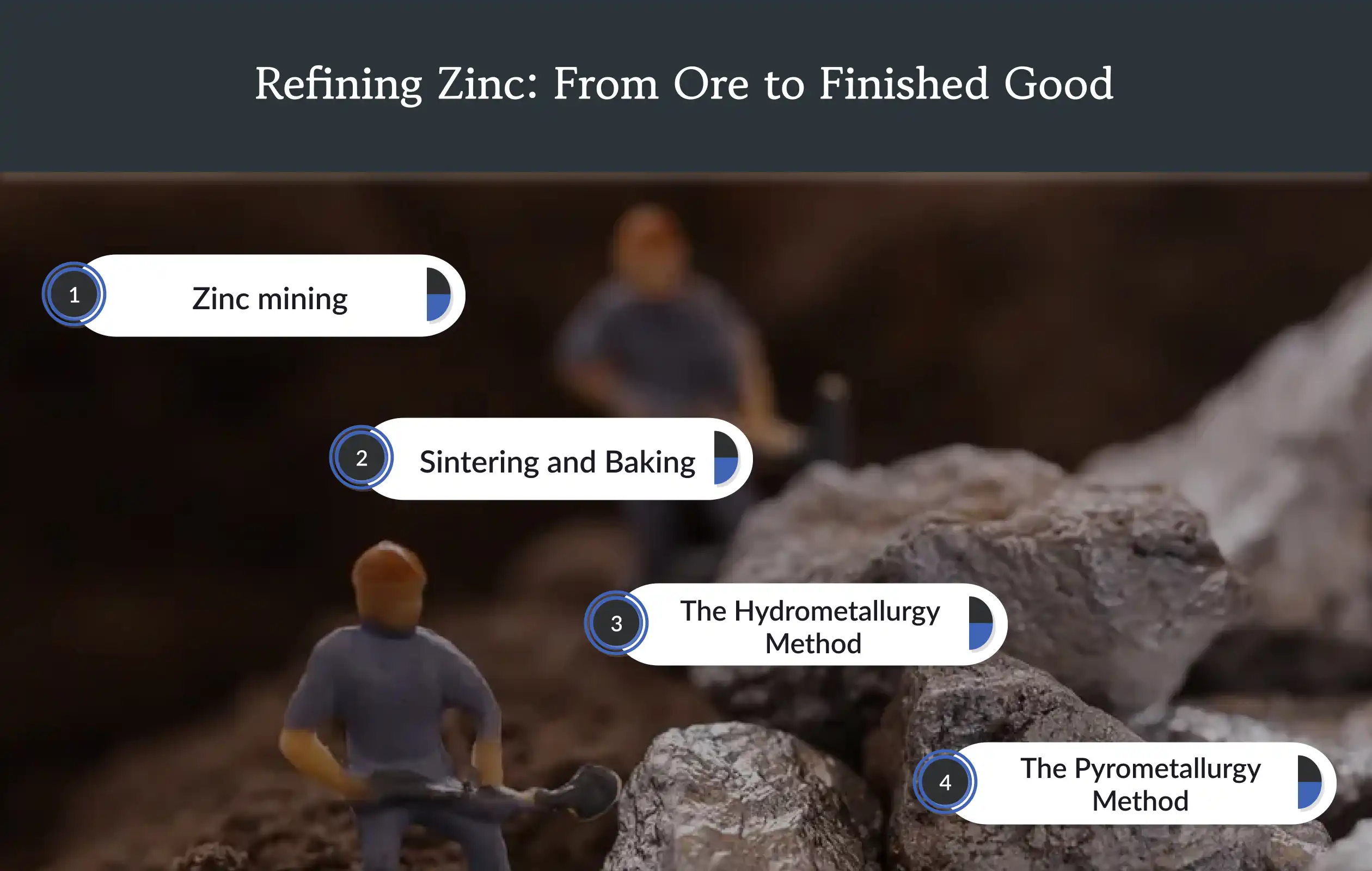
1. Zinc mining
10 percent of zinc mines are hybrids, 8 percent are open pit, and 80 percent are underground. Up to 64% of the world's zinc production comes from underground mines, followed by open pit miners at 15% and underground/open pit mines combined at 21%.
The ore is frequently too rich to utilise directly from the mine, therefore smelters must concentrate it. Ores have a zinc concentration of 5 - 15%. The smelters crush ore and ground into a fine powder to concentrate it and provide the best possible separation from other minerals. Zinc concentrates typically include approximately 55% zinc and trace quantities of lead, copper, and iron.
2. Sintering and Baking
Zinc alloy (ZnS) accounts for 95% of Zinc Production. Apart from zinc, the concentrate also contains sulphur (at least 25–30%), iron, lead, silver, and different concentrations of other minerals. One can recover Metallic zinc by hydrometallurgical or pyrometallurgical processes, but first focus on the sulphur removal from the concentrate by roasting or sintering it first. Zinc sulphide (ZnS) changes into the more active zinc oxide (ZnO) when the one heats the concentrate at 900°C. Additionally, sulphur and oxygen react to form sulphur dioxide. Industries can use this to manufacture sulfuric acid, a useful byproduct in the commercial sector. Environmental regulations affecting mining and smelting operations can lead to sudden changes in zinc prices.
3. The Hydrometallurgy Method
During the leaching phase, sulfuric acid separates the zinc oxide from the other calcines. Zinc dissolves, and iron precipitates, while lead and silver remain undissolved. To achieve a high degree of purity, workers must filter out certain impurities from the dissolved solution.
Workers usually purify the solution by adding zinc dust. Since all the elements that need removal are below zinc in the electrochemical series, they use cementation to precipitate them. In the electrolytic process, workers electrolyze the filtered solution between aluminium cathodes and lead alloy anodes.
An electrical current flows through the electrolyte due to an electrical difference of 3.3 to 3.5 volts between the cathode and the anode, causing the aluminium cathodes to deposit extremely pure zinc.
Workers then remove the deposited zinc, dry it, melt it, and form it into ingots. There are two grades of zinc ingots: Special High Grade (SHG), which has 99.99% zinc, and High Grade (HG), which includes 99.95% zinc. Nowadays, hydrometallurgically produced electrolytic facilities account for over 90% of global zinc production.
4. The Pyrometallurgy Method
In the Imperial Smelting process, carbon converts zinc and lead into metal in a specially designed furnace. The IS process is energy intensive, thus when energy prices went up, so did its cost. Currently, only four nations—China, India, Japan, and Poland—maintain furnaces used for Imperial Smelting. Source
Zinc Mining In India
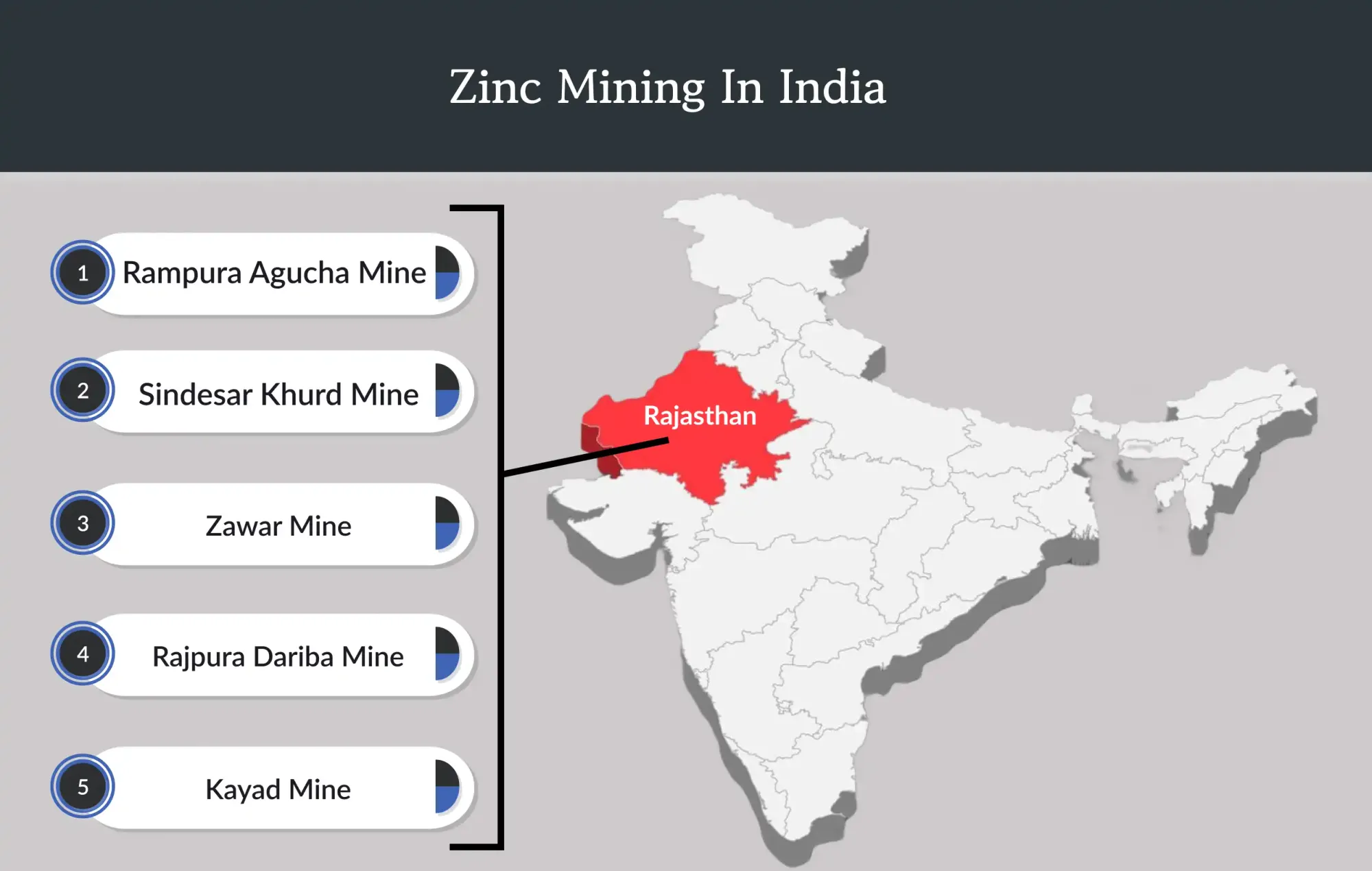
With an anticipated 1.06 million metric tons of zinc concentrate production in 2023, India ranked as the sixth-largest zinc mining nation in the world.
India is home to several of the biggest zinc mines in the world. Changes in zinc prices can affect India’s trade balance, given its role as a major producer and consumer of zinc. With 462.75 thousand tonnes of zinc concentrate produced in 2023, the Rampura Agucha mine ranked second in the world for zinc production. In India, open-pit zinc mining has been prohibited since 2018.
The top five zinc mines in India in 2023 are listed below:
1. Rampura Agucha Mine
The Rampura Agucha Mine in Rajasthan is one such underground mine. The mine is owned by Vedanta Resources and is expected to produce 462.75 thousand tonnes of zinc in 2023. The mine will remain operational until 2033.
2. Sindesar Khurd Mine
Vedanta Resources owns the Rajasthani Sindesar Khurd Mine. In 2023, about 176.54 thousand tonnes of zinc were taken out of the underground mine. In 2029 this mine will close.
3. Zawar Mine
The Zawar Mine is located in the Indian state of Rajasthan. This facility, operated by Vedanta Resources, produced about 116.44 thousand tonnes of zinc in 2023. The mine will remain open until 2031.
4. Rajpura Dariba Mine
Vedanta Resources is the owner of the Kayad Mine, an underground mine located in Rajasthan. It was estimated that the mine will have produced 53.12 thousand tonnes of zinc in 2023. The mine will most probably exhaust in 2034.
5. Kayad Mine
The Rajpura Dariba Mine in Rajasthan is an underground mine owned by Vedanta Resources. It was projected to produce 34.47 thousand tonnes of zinc in 2023. 2026 is when the mine is scheduled to close. Source
The Best Zinc Companies In India
Below is a summary of the top two zinc producing companies in India, along with information about their products, capacities for production, and effects on the country's economy and sustainability of the environment.
Hindustan Zinc Limited (HZL)
Zinc prices can influence the overall GDP growth of India, as the metal plays a critical role in various sectors that contribute to the national economy. Hindustan Zinc Limited (HZL), a well-known Indian mining and resource business specializing in zinc, lead, silver, and cadmium, operates as a subsidiary of Vedanta Limited. In 2003, Vedanta Limited purchased HZL. Before this, it functioned as a Central Public Sector Undertaking.
HZL stands as the world’s second-largest producer of zinc and ranks among the top integrated producers of lead, zinc, and silver globally. The company operates the world's largest zinc mine, the Rampura Agucha mine, in Rajasthan, along with other mines in the state. HZL's Rajasthani smelters and refineries, which have a total capacity of 10 lakh tonnes, process both lead and zinc. Global zinc price trends directly affect the profitability of Hindustan Zinc Limited. Known for cost-effective zinc production, HZL is the world's third-largest operator of open-pit mines.
Additionally, the company has set up a smelting factory in Uttarakhand that produces lead, silver, zinc, and other metals. Although HZL's zinc smelter in Andhra Pradesh has been inactive since February 2012, it remains established.
Mewat Zinc Ltd.
Sizemasters Technology Limited, an Indian company, offers both metal and non-metal products for sale. Among the goods they purchase, process, manufacture, construct, import, export, and sell are zinc ingots, sheets, and derivatives.
The company deals in fabrics and fibres, including cotton, wool, silk, linen, jute, hemp, rayon, synthetic silk, nylon, and other yarns. It also manufactures, colours, dyes, spins, buys, weaves, sells, imports, and handles ordealing.
In January 2023, the company changed its name from Mewat Zinc Limited to Sizemasters Technology Limited. The company, which is headquartered in New Delhi, India, initially welcomed customers in 1991. Source
An Analysis of the Global Zinc Market
The zinc market has experienced robust growth in recent years. It is projected to expand from $27 billion in 2023 to $29.15 billion in 2024, reflecting an annual growth rate of 8.0%. This historical growth is due to increased galvanization in construction, a burgeoning automotive sector, the use of zinc in batteries and alloys, its applications in healthcare and pharmaceuticals, as well as metal coatings and protection.
Looking ahead, the zinc market is expected to continue its strong growth trajectory, reaching $38.87 billion by 2028 with a compound annual growth rate (CAGR) of 7.5%. This anticipated growth is driven by factors such as infrastructure development, construction activities, advancements in renewable energy storage, the rise of electric vehicles (EVs) and transportation, evolving health and wellness trends, and a recovering global economy. Key trends likely to influence the market include the increasing use of zinc as a dietary supplement, market expansion in developing regions, innovative applications in zinc alloys for manufacturing, recycling initiatives, and its growing importance in health and wellness products. Source
Price Fluctuations For Zinc
Among the various international and geopolitical factors influencing zinc pricing are the economic conditions of major producing and consuming countries. Global zinc prices are a barometer for industrial health, reflecting the demand for metals in construction and manufacturing. Currency fluctuations, inventory levels, and the balance between supply and demand all have a major influence on zinc pricing. Since half of the zinc used is used to galvanise steel, the steel and iron ore industries are significant players.
Average prices for zinc globally from 2014 to 2025 (USD/million tonne)

The forecast for zinc prices in 2024 is set at $2,500 per tonne, a decrease from the 2023 average of $2,651 per tonne. This decline is attributed to an oversupply in the market, which is putting downward pressure on prices.
Monthly trend of the price of zinc globally (USD/million tonne)

Initially, there were high expectations for strong demand from China in 2024. However, the outlook for China's growth has become uncertain, and the growth prospects in other major markets are also looking subdued, which will likely limit any significant price increases. Looking further ahead, the long-term forecast for zinc prices from 2024 to 2028 averages around $2,560 per tonne, staying below the levels seen in 2022.
Since the beginning of the 2019 fiscal year, concerns about a global economic downturn, an increase in the value of the US dollar, and conflicts related to international trade have all led to declining zinc prices. Since tariffs like the 25% US steel import charge have spread, zinc prices have dropped to a two-year low.
Conclusion
The dynamics of zinc pricing and production closely affect the global market trends and technological advancements. Zinc production has become more efficient because of modern mining and processing procedures, resulting in higher purity levels and more affordable operations overall. The changes in international trade and economic policy, including tariffs and environmental laws significantly impact the availability and demand for zinc.
FAQs
1. What are the useful applications of Zinc?
Numerous items, such as batteries, galvanised steel (which inhibits rust), and various zinc compounds, depend on zinc for their manufacturing.
2. What is the process for extracting Zinc?
The production process includes mining, concentrating, and either roasting or processing the ore using hydrometallurgical techniques to produce zinc metal.
3. What use does zinc have in industry?
Zinc is a necessary component for numerous industries, such as construction, automotive manufacturing, and household goods, due to its ability to withstand corrosion and the galvanising process.